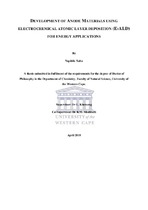| dc.contributor.advisor | Khotseng, Lindiwe | |
| dc.contributor.author | Xaba, Nqobile | |
| dc.date.accessioned | 2018-09-06T10:21:08Z | |
| dc.date.available | 2018-12-31T22:10:06Z | |
| dc.date.issued | 2018 | |
| dc.identifier.uri | http://hdl.handle.net/11394/6390 | |
| dc.description | Philosophiae Doctor - PhD (Chemistry) | |
| dc.description.abstract | Nanomaterials have been found to undeniably possess superior properties than bulk structures
across many fields of study including natural science, medicine, materials science, electronics
etc. The study of nano-sized structures has the ability to address the current world crisis in
energy demand and climate change. The development of materials that have various
applications will allow for quick and cost effective solutions. Nanomaterials of Sn and Bi are
the core of the electronic industry for their use in micro packaging components. These
nanomaterials are also used as electrocatalysts in fuel cells and carbon dioxide conversion,
and as electrodes for rechargeable sodium ion batteries. There are various methods used to
make these nanostructures including solid state methods, hydrothermal methods, sputtering,
and vacuum deposition techniques. These methods lack the ability to control the structure of
material at an atomic level to fine tune the properties of the final product.
This study aims to use E-ALD technique to synthesis thin films of Sn and Bi for various
energy applications, and reports the use of E-ALD in battery applications for the first time.
Thin films were synthesised by developing a deposition sequence and optimising this
deposition sequence by varying deposition parameters. These parameters include deposition
potential, and concentration of precursor solution. The thin films were characterised using
cyclic voltammetry, linear sweep voltammetry, chronoamperometry for electrochemical
activity. These were also characterised using scanning electron microscope for morphology,
x-ray diffraction for crystal phases, energy dispersive spectroscopy for elemental mapping,
and focused ion beam scanning electron microscope for thickness. The elemental content was
analysed using electron probe micro analysis and inductively coupled plasma mass
spectrometry. The electrochemical impedance charge and discharge profile were used for
electrochemical battery tests. | |
| dc.language.iso | en | |
| dc.publisher | University of the Western Cape | |
| dc.subject | Nanomaterials, Electrodeposition, Underpotential, Thin films, Electrocatalyst, Anode, Fuel cells, Sodium ion battery, Carbon dioxide reduction | |
| dc.title | Development of Anode Materials Using Electrochemical Atomic Layer Deposition (E-ALD) for Energy Applications | |
| dc.rights.holder | University of the Western Cape | |

